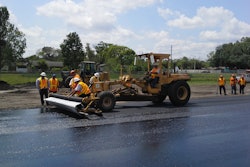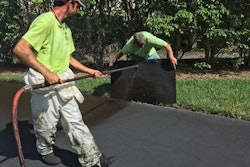In the 1980s and 90s, the US Army Corps of Engineers (ACOE) and the Federal Aviation Administration (FAA) tested asphalt pavement sealcoats and developed criteria for their use at airports. The lead ACOE engineer explained the concern:
Fuel spills and drippage result in the softening and leaching away of asphalt binder from the aggregate. This causes pavement failures due to rutting or raveling of the surface aggregate in the spillage areas. …Parking areas, especially those with constant vehicle turnover, are very susceptible to damage from such spillage. Vehicles have a tendency to lose more fuels either at start-up periods or immediately after shutdown of the engine. ,,. Fuel spillage problems can also be particularly severe for airfield pavements… (Shoenberger, 1994, Journal of Materials in Civil Engineering).
The reports emphasized that sealcoat performance should be measured with two different goals in mind: (1) protection of the underlying asphalt pavement from oxidation, weathering, and non-petroleum chemicals, and (2) protection from seepage of leaked or spilled petroleum products into the underlying asphalt. The ACOE and FAA evaluated the performance of various asphalt-based and refined tar-based sealcoats with regard to preparation of existing pavement surfaces, mixtures of materials, application methods, climatic conditions, adhesion, fuel resistance, cracking, workability, skid resistance, and other important characteristics. Both the ACOE and the FAA reports remarked that, at that time (1980s and early 90s) there was considerable inconsistency among similar products. For example, some products contained more sand than others, leading to significant differences in parameters such as workability and skid resistance. Some had more additives such as polymer; some had less, leading to yet more differences in characteristics. And contractors had differing theories about application parameters. The inconsistencies meant each batch of sealant products needed to be tested to ensure desired performance speciications were met.
PCTC was founded, in part, from the need for consistency. PCTC has established standards for refined coal tar-based sealants (RTS) to assist customers prepare specifications. PCTC’s specification guides (PCTC-01, without additives, and PCTC-02, with additives) have now been available for almost 20 years. They can be downloaded from PCTC’s web site, www.pavementcouncil.org. The specification guides compliment the series of ASTM® standards that cover everything from the specification for the base ingredient, RT-12, to formulating sealants, to application of sealant on asphalt pavements of airports, parking lots, and driveways. Links to the ASTM® standards can be accessed www.pavementcouncil.org.
Work continues on developing standards for long-term protection and fuel resistance for asphalt-based sealants as well as for recently developed sealants. The ACOE’s Shoenberger noted that
Because [fuel resistant sealants] are a surface treatment and highly visible, failures of the seal coat to adhere to the pavement, cure, or otherwise perform as expected draw immediate and negative attention.
With 7 decades of usage experience, proven standards in place, a low failure rate, reliable performance, and durability, RTS remains the leader in the sealant marketplace.



















